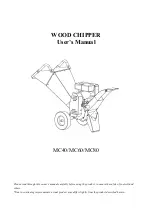
Page 62
Maintenance
9.3 Refrigerant charge
Do not inject refrigerant liquid into the LP
side of the circuit. Be very careful, and
charge the circuit properly. If the charge is
insufficient, the efficiency of the unit will be
lower than expected. In the worst of cases
the LP pressure switch may be activated, re-
sulting in the halting of the unit.
In the presence of an excess charge, the
condensing pressure will rise (in the worst
of cases, the HP pressure switch may be ac-
tivated, resulting in the stop of the equip-
ment), and the consumption will increase as
well.
It is strictly forbidden to use the compressor
as a vacuum pump to drain the plant.
Fill the refrigeration circuit after it has been drained
for maintenance purposes (leaks, replacement of the
compressor etc.). The amount of the charge is indi-
cated on the plate affixed to the unit.
Before refilling, it is important to drain and de-hy-
drate the circuit, thus obtaining a minimum abs. pres-
sure value of 50 Pa.
Inject the refrigerant fluid before removing the vacu-
um, then fill the circuit up to 90% of the total gas re-
quirement (in liquid form). The appliance must be
filled through the filling valve on the liquid line, on
the outlet side of the condenser.
It is recommended to connect the refrigerant cylinder
to the filling valve on the liquid line, and to arrange it
in such a way as to inject only liquid refrigerant.
Then start the compressor and let the gas flow from
the cylinder, up until the liquid flow, which can be
observed through the sight glass, is limpid.
9.4 Compressor
The frequency of the checks to be made on compres-
sors depends on a variety of factors, first of all the
working conditions. Anyway, it is advisable to adopt
the following tips:
h
After 300 hours of work, check the conditions of
the oil: a certain amount of impurities from the sys-
tem may accumulate in the oil of the compressors.
h
Check the acidity of the oil every year.
h
After 8000 hours of work, carry out a visual in-
spection on the suction/discharge valves for wear.
If necessary, replace these components. If com-
pressors are started/stopped frequently or in par-
ticularly demanding working conditions, it is advis-
able to reduce this period to 5000 hours. Anyway,
this time is indicative only.
h
After 24000 hours of work, carry out a general
overhaul of the compressor. If the compressors
work for a period shorter than 40% of a year, the
overhaul can be performed every about 5 years.
This period depends on the type of application, the
working conditions, the duration of start/stop cy-
cles.
If it is necessary to replace the compressor
(in case of burning of the winding or me-
chanical failure), contact one of Itelco-Cli-
ma’s Service Centres.
The compressors use polyester oil. During
maintenance operations on the compressor,
or if it opens in any point of the refrigerant
circuit, do not forget that this type of oil is
highly hygroscopic, and accordingly do not
leave it exposed to the atmosphere, as this
would require the replacement of the oil.
9.5 Condenser’s coils
The condenser’s coils consist of copper pipes and
aluminium fins. In the presence of leaks caused by
any damage or shock, the coils shall be repaired or
replaced by one of Itelco-Clima’s authorised Service
Centers. To ensure the effective and correct opera-
tion of the condenser coils, it is important to keep the
condenser’s surface perfectly clean, and to check
that there is no foreign matter, such as leafs, wires,
insects, waste etc. If the coil becomes dirty, there is
an increase in the absorption of electric energy. Fur-
thermore, the maximum pressure alarm may be acti-
vated and may halt the unit.
Be careful not to damage the aluminium fins
during cleaning.
The condenser must be cleaned with a LP com-
pressed air jet, parallel to the aluminium fins, in the
direction opposite to the air circulation.
To clean the coil you can use also a vacuum cleaner,
or a jet of water and soap.
Manuale SLS-SLH2 2.8.2005 12:23 Pagina 62







































